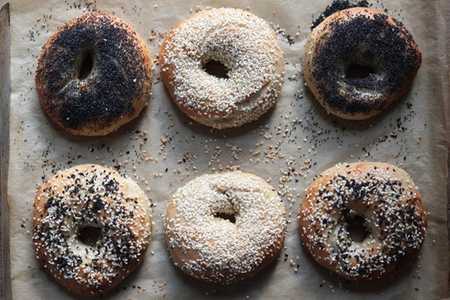- 3 1/2 cups (1 pound) unbleached flour (see note above)
- 3 teaspoons coarse kosher salt, divided
- 3/4 teaspoons instant yeast
- 1 tablespoon honey (see note above)
- 1 cup plus 2 tablespoons room-temp or slightly warm water
- 1 teaspoon baking soda
- 1 egg white, optional Seeds!
- Mix the flour, 2 teaspoons of the salt, the yeast, honey, and the water until everything begins to form into dough. You can use a mixer if you like, but it's simpler by hand. It'll be a stiff dough, as there's not much water, but this makes it sturdy enough to withstand a dunk in boiling water later. Feel free to add a bit more water if necessary, but you shouldn't need much.
- Let the dough rest for 5 minutes while you find a place in your tiny apartment on which to knead.
- Knead on a floured surface for about 3 minutes -- the dough will get smooth, a little tacky.
- Now put your lovely little dough ball into an oiled boil, cover it with plastic wrap, and let it hang in the fridge for a few hours, or at least an hour. (I've left it for both 45 minutes and 4 hours, and both batches turned out fine.)
- When you're ready to shape the bagels, line a baking sheet with lightly greased parchment paper. Then remove the dough from the fridge, and cut it into 6 or 8 pieces, depending on how large or small you'd like your bagels to be. (I find that 6 pieces yields my kind of bagel: not puny.) Form each piece into a ball, and then each ball into a 10-inch log, with tapered ends. (Don't use any flour on your surface! You'll need the dough to stick just slightly in order for it to change shape.)
- To shape the bagels, place one end of one dough log in between your thumb and forefinger, and then wrap it around the rest of your fingers -- the dough ends should overlap by an inch or two -- and squeeze it slightly to bind it together. Once you do this, you can also roll the ends together on a surface to enhance the seal. Extra security is never a bad thing.
- Repeat for all of the bagels, then lightly oil them and cover with plastic wrap. Put them in the fridge to proof overnight. Invite guests over for brunch.
- About an hour an a half before you want to bake them, pull the bagels out of the fridge to come to room temperature, and fill a large pot (I use a Dutch oven) to at least 4 inches deep. Cover and bring it to a boil. When it boils, add 1 teaspoon of salt and the baking soda, then turn it down to a simmer.
- Crank the oven to 500° F.
- Now test the bagels by using the float test: fill a bowl with cold water, and place one bagel in it. If it floats, they're all ready to go. If not, you haven't failed: just return it to the baking sheet and let proof for 15 to 20 minutes more, then do the test again.
- Working in batches that will fit in your pot, carefully drop each bagel into the simmering water, let poach for 1 minute, and flip with a slotted spoon or a spider. Poach 30 seconds more, and then return each bagel to the baking sheet.
- And, the fun part: sprinkle your bagels with whatever topping you want. To help your toppings stick, use an egg white wash, but the residual water from the poach should do the trick, too. Seeds are great, as is big flake or rock salt.
- You're so close: slip them in the oven and reduce the heat to 450° F. Bake for 8 minutes, rotate the sheet, and bake 8 to 12 minutes more, until the bagels are golden brown. Feel free to check the bottom of the bagels as they cook -- if they're getting too brown, just stick another baking sheet underneath them (a baking stone works, too).
- Pull them from the oven, and wait an excruciating 30 minutes before you eat them.
